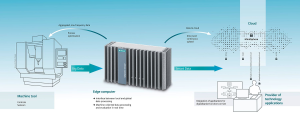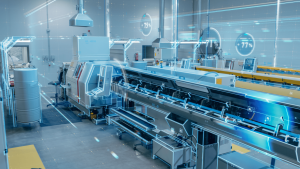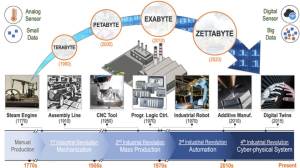Big Data in CNC Manufacturing: Principles, Applications, and Challenges
In recent years, the integration of Big Data analytics into manufacturing, particularly in CNC (Computer Numerical Control) machining, has significantly transformed production processes. By harnessing vast amounts of data generated from CNC machines, manufacturers can optimize production efficiency, enhance quality control, and make informed decisions. Big Data offers unprecedented insights into machine performance, part quality, and operational efficiency. This paper explores the principles of Big Data in CNC manufacturing, its applications, and the challenges involved in its implementation.

Principles of Big Data in CNC Manufacturing
Big Data refers to large volumes of data that can be analyzed computationally to reveal patterns, trends, and associations, particularly related to human behavior and interactions. In the context of CNC manufacturing, Big Data is generated through various sources, including machine sensors, CNC controllers, and the entire production ecosystem. The data can include machine parameters such as temperature, vibration, power consumption, tool wear, and cycle times, among others.
The primary characteristics of Big Data in CNC manufacturing are often described using the “4 Vs”:
- Volume: The large amount of data generated by CNC machines, sensors, and connected devices.
- Velocity: The speed at which data is generated and must be processed in real time.
- Variety: The different types of data, such as sensor data, machine logs, and production metrics.
- Veracity: The quality and accuracy of the data, which must be reliable for meaningful analysis.
By collecting, storing, and analyzing this data, manufacturers can make data-driven decisions that improve efficiency, reduce downtime, and predict failures before they occur.

Applications of Big Data in CNC Manufacturing
Big Data analytics offers several transformative applications in CNC manufacturing, making it a powerful tool for optimization and continuous improvement.
1. Predictive Maintenance
One of the most significant applications of Big Data in CNC manufacturing is predictive maintenance. By continuously monitoring CNC machine data such as vibration levels, temperature fluctuations, and power consumption, manufacturers can detect early signs of wear or malfunction. Machine learning algorithms can analyze historical data to predict potential failures, allowing for maintenance to be scheduled proactively, thereby reducing unplanned downtime and preventing costly repairs.
For instance, if a machine’s motor begins to show signs of overheating, the system can alert the operator before the motor fails completely. This predictive capability reduces production interruptions, improves machine lifespan, and ensures consistent part quality.
2. Process Optimization
Big Data can also be used to optimize CNC machining processes by analyzing performance data to fine-tune machine settings, tool usage, and production parameters. By analyzing real-time data from sensors, manufacturers can adjust parameters such as spindle speed, feed rate, and cutting force to maximize efficiency and precision.
Additionally, through advanced analytics, manufacturers can identify trends and correlations that suggest improvements in machining techniques or adjustments to material handling processes. For example, analyzing tool wear data over time can help determine the optimal tool change intervals, improving both productivity and part quality.

3. Quality Control and Defect Detection
In CNC manufacturing, maintaining product quality is paramount. Big Data analytics can help detect defects in real time by continuously monitoring machine parameters and comparing them to predefined quality thresholds. For example, vibration data from a CNC machine can be analyzed to detect irregularities in the machining process that may lead to surface defects on parts.
Furthermore, data analytics can identify patterns in defect occurrence and root causes, enabling manufacturers to address underlying issues in the production process. By integrating real-time quality control with Big Data analytics, manufacturers can prevent defects before they occur, ensuring higher product quality and reducing scrap rates.
Challenges of Implementing Big Data in CNC Manufacturing
While the benefits of Big Data in CNC manufacturing are clear, there are several challenges in implementing and effectively utilizing these technologies.

1. Data Integration and Interoperability
In a typical CNC manufacturing environment, data is generated from various sources, including different types of machines, sensors, and software platforms. Integrating these data sources into a unified system that allows for comprehensive analysis is a significant challenge. Many CNC machines and systems use proprietary protocols, making it difficult to achieve seamless data exchange between devices and software platforms.
Manufacturers must invest in interoperable systems that can consolidate and standardize data from multiple sources. This may involve upgrading existing infrastructure, implementing open-source data protocols, or using middleware solutions to facilitate communication between devices.
2. Data Security and Privacy
With the vast amount of data being generated, data security and privacy become critical concerns. Protecting sensitive manufacturing data, especially when it comes to proprietary designs and production methods, is essential to maintaining competitive advantage and preventing cyberattacks. CNC manufacturers must implement robust cybersecurity measures to ensure that their data is secure from breaches.
Additionally, manufacturers must comply with data privacy regulations, particularly in industries where sensitive data (such as medical device production) is involved. Ensuring compliance with these regulations can add complexity to the data management process.
3. Skilled Workforce and Data Analytics Expertise
The successful implementation of Big Data in CNC manufacturing requires skilled personnel who can interpret and analyze large datasets. Data scientists and engineers with expertise in data analytics, machine learning, and predictive modeling are essential to unlock the full potential of Big Data in manufacturing.
As the demand for data-driven decision-making increases, manufacturers must invest in workforce training and development to ensure that their employees are equipped with the necessary skills. The shortage of skilled workers in data science and analytics poses a challenge to the widespread adoption of Big Data in CNC manufacturing.
Conclusion
Big Data has the potential to revolutionize CNC manufacturing by enhancing efficiency, improving quality, and reducing costs. By leveraging data from CNC machines, manufacturers can optimize processes, predict maintenance needs, and detect defects in real time. However, the successful implementation of Big Data requires overcoming challenges such as data integration, security, and the need for skilled expertise. As CNC manufacturing continues to evolve, the integration of Big Data will play a pivotal role in shaping the future of the industry, enabling smarter, more efficient, and more flexible production systems.








